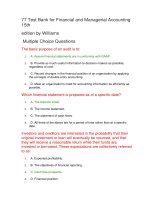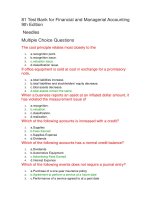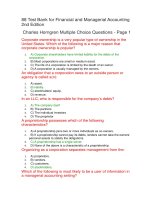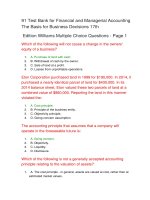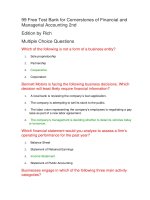Financial and managerial accounting 2nd kimel kieso willey chapter 26
Bạn đang xem bản rút gọn của tài liệu. Xem và tải ngay bản đầy đủ của tài liệu tại đây (2.68 MB, 59 trang )
26-1
26
Planning for Capital Investments
Learning Objectives
26-2
1
Describe capital budgeting inputs and apply the cash payback technique.
2
Use the net present value method.
3
Identify capital budgeting challenges and refinements.
4
Use the internal rate of return method.
5
Use the annual rate of return method.
LEARNING
OBJECTIVE
1
Describe capital budgeting inputs and apply the cash payback
technique.
Corporate capital budget authorization process:
26-3
1.
Proposals for projects are requested from each department.
2.
Proposals are screened by a capital budget committee.
3.
Officers determine which projects are worthy of funding.
4.
Board of directors approves capital budget.
LO 1
Authorization Process
Many companies follow a carefully prescribed process in capital budgeting.
Illustration 26-1
Corporate capital budget
authorization process
26-4
LO 1
Cash Flow Information
For purposes of capital budgeting, estimated cash inflows and outflows are the preferred inputs.
Why?
Ultimately, the value of all financial investments is determined by the value of cash flows received
and paid.
26-5
LO 1
Cash Flow Information
Typical cash flows relating to capital budgeting decisions.
Cash Outflows
Illustration 26-2
Initial investment
Repairs and maintenance
Increased operating costs
Overhaul of equipment
Cash Inflows
Sale of old equipment
Increased cash received from customers
Reduced cash outflows related to operating costs
Salvage value of equipment
26-6
LO 1
Cash Flow Information
Capital budgeting decisions depend on:
26-7
1.
Availability of funds.
2.
Relationships among proposed projects.
3.
Company’s basic decision-making approach.
4.
Risk associated with a particular project.
LO 1
Illustrative Data
Stewart Shipping Company is considering an investment of $130,000 in new equipment.
Illustration 26-3
26-8
LO 1
Cash Payback
Cash payback technique identifies the time period required to recover the cost of the capital
investment from the net annual cash inflow produced by the investment.
Illustration 26-4
Cash payback period for Stewart is …
$130,000 ÷ $24,000 = 5.42 years
26-9
LO 1
Cash Payback
Shorter payback period = More attractive the investment
In the case of uneven net annual cash flows, the company determines the cash payback period when
the:
Cumulative net cash flows
from the investment
26-10
=
Cost of the investment
LO 1
Cash Payback
Illustration: Chen Company proposes an investment in a new website that is estimated to cost
$300,000.
Illustration 26-5
Computation of cash payback period—
Cash payback should not be the only basis for the capital budgeting decision as it
unequal cash flows
ignores the expected profitability of the project.
26-11
LO 1
Cash Payback
Question
A $100,000 investment with a zero scrap value has an 8-year life. Compute the payback period if
straight-line depreciation is used and net income is determined to be $20,000.
26-12
a.
8.00 years.
b.
3.08 years.
c.
5.00 years.
d.
13.33 years.
LO 1
DO IT!
1
Cash Payback Period
Watertown Paper Corporation is considering adding another machine for the manufacture of corrugated cardboard.
The machine would cost $900,000. It would have an estimated life of 6 years and no salvage value. The company
estimates that annual cash inflows would increase by $400,000 and that annual cash outflows would increase by
$190,000. Compute the cash payback period.
26-13
LO 1
LEARNING
2
OBJECTIVE
Use the net present value method.
Discounted cash flow technique:
26-14
Generally recognized as the best approach.
Considers both the estimated total cash inflows and the time value of money.
Two methods:
►
Net present value (NPV).
►
Internal rate of return (IRR).
LO 2
Net Present Value (NPV) method
Cash inflows are discounted to their present value and then compared with the capital outlay
required by the investment.
26-15
The interest rate used in discounting is the required minimum rate of return.
Proposal is acceptable when NPV is zero or positive.
The higher the positive NPV, the more attractive the investment.
LO 2
Net Present Value (NPV)
Illustration 26-6
Net present value decision criteria
method
Proposal is acceptable when net
present value is zero or positive.
26-16
LO 2
Equal Annual Cash Flows
Illustration: Stewart Shipping Company’s annual cash flows are $24,000. If we assume this amount is uniform
over the asset’s useful life, we can compute the present value of the net annual cash flows.
Illustration 26-7
Computation of present value
of equal net annual cash flows
26-17
LO 2
Equal Annual Cash Flows
Illustration 26-8
Illustration: Calculate the present value.
Computation of net present value—equal net
annual cash flows
The proposed capital expenditure is acceptable at a required rate of return of 12% because the net
present value is positive.
26-18
LO 2
Unequal Annual Cash Flows
Illustration: Stewart Shipping Company expects the same total net cash flows of $240,000 over
the life of the investment. Because of a declining market demand for the new product the net
annual cash flows are higher in the early years and lower in the later years.
26-19
LO 2
Unequal Annual Cash Flows
Illustration 26-9
Computation of present value of unequal annual cash
flows
26-20
LO 2
Unequal Annual Cash Flows
Illustration 26-10
Illustration: Calculate the net present value.
Computation of net present value—
unequal annual cash flows
Proposed capital expenditure is acceptable at a required rate of return of 12% because the net
present value is positive.
26-21
LO 2
Management Insight
Verizon
Can You Hear Me Me—Better?
What’s better than 3G wireless service? 4G. But the question for wireless service providers is whether customers will
be willing to pay extra for that improvement. Verizon has spent billions on upgrading its networks in the past few years,
so it now offers 4G LTE service to 97% of the nation. Verizon is hoping that its investment in 4G works out better than
its $23 billion investment in its FIOS fiber-wired network for TV and ultrahigh-speed Internet. One analyst estimates
that the present value of each FIOS customer is $800 less than the cost of the connection.
Sources: Martin Peers, “Investors: Beware Verizon’s Generation GAP,” Wall Street Journal Online (January 26, 2010); and Chad Fraser,
“What Warren Buffett Sees in Verizon,” Investing Daily (May 30, 2014).
26-22
LO 2
Choosing a Discount Rate
In most instances a company uses a required rate of return equal to its cost of capital — that is,
the rate that it must pay to obtain funds from creditors and stockholders.
Discount rate has two elements:
Cost of capital
Risk
Rate also know as
26-23
required rate of return.
hurdle rate.
cutoff rate.
LO 2
Choosing a Discount Rate
Illustration: Stewart Shipping used a discount rate of 12%. Suppose this rate does not take into
account the risk of the project. A more appropriate rate might be 15%.
Illustration 26-11
Comparison of net present values at different discount rates
26-24
LO 2
Simplifying Assumptions
26-25
All cash flows come at the end of each year.
All cash flows are immediately reinvested in another project that has a similar return.
All cash flows can be predicted with certainty.
LO 2



